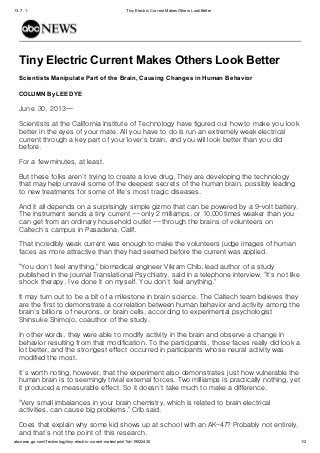
[ABC] tiny electric current makes others look better
- 1. 13. 7. 1. TinyElectric Current Makes Others LookBetter abcnews.go.com/Technology/tiny-electric-current-makes/print?id=19522430 1/2 Tiny Electric Current Makes Others Look Better Scientists Manipulate Part of the Brain, Causing Changes in Human Behavior COLUMN By LEE DYE June 30, 2013— Scientists at the California Institute of Technology have figured out how to make you look better in the eyes of your mate. All you have to do is run an extremely weak electrical current through a key part of your lover's brain, and you will look better than you did before. For a few minutes, at least. But these folks aren't trying to create a love drug. They are developing the technology that may help unravel some of the deepest secrets of the human brain, possibly leading to new treatments for some of life's most tragic diseases. And it all depends on a surprisingly simple gizmo that can be powered by a 9-volt battery. The instrument sends a tiny current -- only 2 milliamps, or 10,000 times weaker than you can get from an ordinary household outlet -- through the brains of volunteers on Caltech's campus in Pasadena, Calif. That incredibly weak current was enough to make the volunteers judge images of human faces as more attractive than they had seemed before the current was applied. "You don't feel anything," biomedical engineer Vikram Chib, lead author of a study published in the journal Translational Psychiatry, said in a telephone interview. "It's not like shock therapy. I've done it on myself. You don't feel anything." It may turn out to be a bit of a milestone in brain science. The Caltech team believes they are the first to demonstrate a correlation between human behavior and activity among the brain's billions of neurons, or brain cells, according to experimental psychologist Shinsuke Shimojo, coauthor of the study. In other words, they were able to modify activity in the brain and observe a change in behavior resulting from that modification. To the participants, those faces really did look a lot better, and the strongest effect occurred in participants whose neural activity was modified the most. It's worth noting, however, that the experiment also demonstrates just how vulnerable the human brain is to seemingly trivial external forces. Two milliamps is practically nothing, yet it produced a measurable effect. So it doesn't take much to make a difference. "Very small imbalances in your brain chemistry, which is related to brain electrical activities, can cause big problems," Crib said. Does that explain why some kid shows up at school with an AK-47? Probably not entirely, and that's not the point of this research.
- 2. 13. 7. 1. TinyElectric Current Makes Others LookBetter abcnews.go.com/Technology/tiny-electric-current-makes/print?id=19522430 2/2 This may be the most important part -- the neural activity took place in the midbrain, an extremely important part of the brain that encompasses the reward system that drives so much human action, and it had been thought that this type of technology could not reach that deeply into the brain. The technology is called "transcranial direct-current stimulation (tDCS)," which Crib described as "cheap, simple and safe." It has been used for years to study areas of the brain that are just below the scalp, but the Caltech team figured out how to make it penetrate deeper into the brain by in effect hitchhiking on another part of the brain that is closer to the surface. The method involves placing an anode and a cathode on two locations on the scalp, and a small current passes from the cathode through the brain to the anode. The brain is an electronic marvel as much as it is a biochemical device. It produces its own current that empowers the brain's nerve cells. So adding a little more current is no big deal. Some 99 volunteers agreed to be wired up and placed inside a functional magnetic resonance imaging scanner. Most of those acted as controls, including some who were wired up but did not receive the current, but 19 got the full treatment. While in the scanner they were asked to rate the attractiveness of a series of human images, both before and after the current was applied. The scanner monitored activity in two areas, one just behind the forehead, which is close enough to the surface for the technology to manipulate. The researchers theorized that if they used the weak current to deactivate that area, that would cause a rise in activity in the midbrain -- the area they could not reach directly. And that's exactly what they found. They were able to increase activity in the midbrain, the reward center, and that caused an increase in the perception of attractiveness in the images. A tiny electrical stimulation caused a behavioral response, and the stronger the stimulation, the better looking the images seemed. None of the controls experienced anything like that. Crib said the team has passed the proof of concept phase, but much more remains to be done. This technique could not measure an increase in dopamine -- sometimes called the love drug, which can also result in many psychiatric disorders if the supply is insufficient -- in the reward center, so the entire experiment must be repeated with a different scanner, probably positron emission tomography (PET.) If it passes that milestone, it will probably move quickly into clinical trials because it may be useful in the treatment of such devastating diseases as Parkinson's and depression. Copyright © 2013 ABC News Internet Ventures
